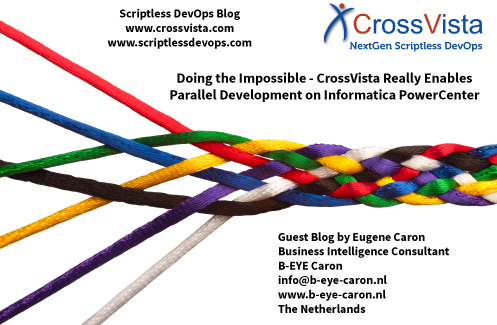DOING THE IMPOSSIBLE – CROSSVISTA REALLY ENABLES PARALLEL DEVELOPMENT ON INFORMATICA POWERCENTER

I am a business intelligence specialist working for over 20 years with Informatica PowerCenter. In my profession I often meet larger customers that struggle with managing a multi-repository environment serving many teams of developers. Key questions are how to first separate the work over teams and, after development, re-integrate the work back into a single baseline representing the BI-system. During my years I ran into lots of different attempts to achieve this. Things like functional segregation, keeping of a separate administration on PowerCenter object-level, attempts to use versioning tools like GIT or Subversion, even attempts to create software that can automatically merge two versions of a mapping, etcetera.
The main challenge is to identify and iron out collisions that will occur between the work done by the various teams and developers making different changes to the same objects. The tooling needs to identify these problems and it should give the opportunity to iron them out before moving to the next stage. Furthermore the tool should ‘know’ PowerCenter and the way a change for instance in a session can mess up things in a worklet or a change in a mapplet can impact one or more mappings.
All of the attempts I saw before had obvious drawbacks, usually involving lots of manual work and custom programming based on pmrep or on interpretation of exported Powercenter XML.
There used to be no tool on the market that could cope with the problems in an elegant matter. Until in one assignment I stumbled onto CrossVista TEAM Server (www.crossvista.com). The tool steps in between any number of PowerCenter repositories at one side and a versioning control system of choice on the other side simulates successfully the model of baselining, branching and merging. It keeps track of all PowerCenter changes, really being aware of the structure of the PowerCenter code and synchronizing with all the changes being done in the underlying live repository. When promoting and deploying changes to a different environment CrossVista is able to collect the changes into a patch, investigate the possible collisions and, after these conflicts are solved, apply them to any other repository in the setup.
At any time teams or individual developers can pick up the whole or part of the work done and transport it to another development or test repository or to the system’s baseline. CrossVista introduces the flexibility needed to branch and merge almost limitlessly in a multi-repository environment, allowing to scale up development over multiple teams as needed. It gives you the tools to give every team, every feature or even every individual developer a dedicated PowerCenter repository to develop in, knowing that CrossVista will merge the changes back to the baseline in a controlled way.
Thanks to CrossVista we could really scale up PowerCenter development, giving each development team their own independent repositories, without need to worry or spend lots of time on integrating the work back to the central baseline.
Eugene Caron
Business Intelligence Consultant
B-EYE Caron
info@b-eye-caron.nl
www.b-eye-caron.nl
The Netherlands

CrossVista provides a “Scriptless” DevOps solution for enterprise applications that manages change across the SDLC from Development through Production Deployment and everywhere in-between. The scriptless devops engine is integrated with technologies such as Informatica PowerCenter/BDM/IDQ,SoftwareAG’s webMethods platform, IBM Websphere (WAS/IIB/MQ), Salesforce.com, Tableau, Cloudera, Amazon Redshift, various databases, file based systems, and more. The engine eliminates the need for complex scripts normally required to support these technologies… no more writing a bunch of scripts to manage your SDLC processes.
Share This Story, Choose Your Platform!